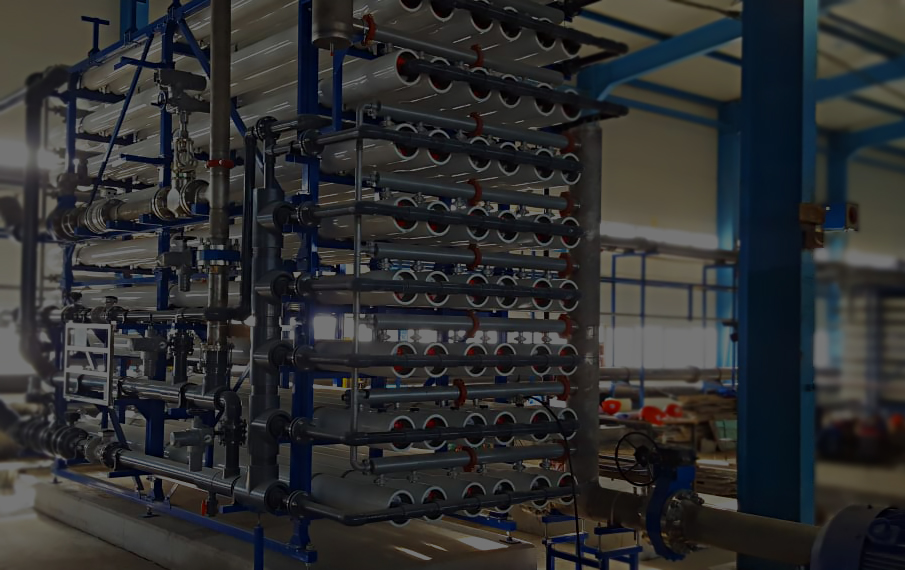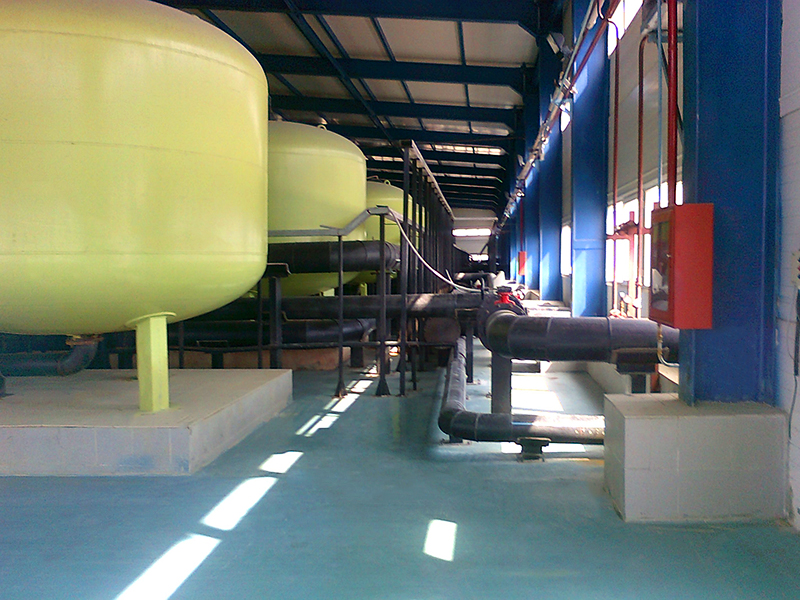
Water treatment and desalination stations
Keldysh Research Center develops and manufactures water treatment stations of any capacity and purpose including water stations for hospitals & hotels, as well as water desalination complexes to meet city population needs.
Water Treatment Technologies
We offer a full range of services in the field of water treatment such as a choice of water purification technology, development of project documentation, equipment manufacturing and delivery, assembly operations, pre-commissioning activities, service maintenance and staff training.
Water treatment stations of Keldysh Research Center have been successfully operating in the territory of the Russian Federation, Kazakhstan, the Republic of South Africa, Israel and China.
Our advantages:
- Development of water treatment stations for drinking and process water, development of sewage water treatment stations;
- Modular stations that allow increasing capacity by the means of simple additional modules connection;
- Laboratory research in order to choose chemical reagents and their optimal dosages necessary for the effective process implementation. Development of experimental stations of a low capacity to simulate a large-scale industrial process if necessary;
- Implementation of low-waste technologies (zero liquid discharge) that helps to reduce the number of contaminated natural areas. Especially relevant for sewage water treatment.
We offer the construction of seawater desalination complexes using the reverse osmosis technology of any capacity that allows producing drinking water that complies with SanPin (Sanitary Regulations and Norms) requirements 2.1.4.1074-01.
The salt content in drinking water does not exceed 100 mg/l because of advanced reverse osmosis membranes with the selectivity up to 99, 8%. It is possible to install mineralization modules if necessary. In this case, calcium salts are added into desalinated water to optimize pH value and to make drinking water healthy and pleasant to drink.
In addition to desalination process, the use of reverse osmosis systems guarantees the complete elimination of all organic substances, bacteria and viruses. Water becomes sterile without thermal treatment, and all suspended and colloidal particles are eliminated during a pre-treatment stage.
Promising Desalination Plant for the production of desalinated water
Our works:
THE CASPIY PLANT FOR SEA WATER DESALINATION (Aktau city, Kazakhstan)
The largest desalination plant in the CIS was built with the use of the original membrane desalination technology to provide Aktau citizens with drinking water taken from the Caspian Sea. The modern achievements in the field of filtration, boron removal from water and desalinated permeate conditioning are used in the plant.

Capacity 20 000 m3 / day => Modernization up to 40 000 m3 /day
|
Parameter |
Caspian Sea water |
Drinking water |
|
Capacity |
Consumption of 50 000 m3/day |
20 000 m3/day |
|
Salinity |
No more than 15 000 mg/l |
No more than 350 mg/l |
|
pH |
8,0-8,2 |
7,5-8,0 |
|
Boron |
3,0-4,0 mg/l |
< 0,5 mg/l |
|
Calcium |
300 mg/l |
Not more than 30 mg/l |
|
Fluorides |
2 mg/l |
0,7 mg/l |
|
Recovery |
1st stage 50%; 2d stage 75% |
|
|
Occupied area |
4,0 ha |
|
|
Power consumption |
3,5-4,0 kW/m3 |
|
Peculiarities of technology:
-
Boron removal up to 95% using two-stage reverse osmosis desalination technology;
-
Medium pressure membranes allow to significantly reduce energy consumption;
-
Opportunity to turn off the 2d stage of desalination process in winter in order to reduce expenses.
DRINKING WATER TREATMENT STATIONS FOR THE BAIKONUR COSMODROME
Technical buildings in the Baikonur Cosmodrome are located in different parts of the launch site territory at a considerable distance from centralized sources of water supply. Because of this, price for supplied water is high and water quality is poor. Therefore, works on the development of autonomous water supply systems have being conducted with the use of desalination technologies for artesian brackish waters, which are everywhere found in the territory of the Baikonur Cosmodrome.

TECHNICAL SPECIFICATIONS:
|
Parameter |
Well |
Drinking water |
|
Total mineralization, mg/l |
6 500-8 000 |
No more than 100 |
|
Hardness, mg/l |
243-290 |
No more than 1,0 |
|
Chlorides, mg/l |
1 700-2 600 |
No more than 30 |
|
Sulphates, mg/l |
1 600-3 500 |
No more than 30 |
|
pH |
7,5-7,8 |
6,5-7,5 |
Autonomous water supply station at area 2g
Two stage reverse osmosis desalination of brackish artesian water. The first station with the capacity of 200 m3/day was put into service in December 1999. Thanks to service maintenance and equipment modernization implemented in time, the station capacity was increased up to 400 m3/day.
Drinking water station of improved quality for the Cosmonaut Hotel (area 17)
The station capacity is 5 m3/h that is at least 80% of the initial water consumption by station.
THE AUTOTOR PLANT (Kaliningrad city, Russia)
Modernization and expansion of deionized water production for the car painting workshop at the Avtotor enterprise. The enterprise located in the Kaliningrad region is one of the leaders on the car market and it produces BMW and KIA models.
In 2013, Keldysh Research Center upgraded the technology and increased deionized water production for KIA car bodies painting workshop:
-
Pre-filtration and micro filtration modules (operated since 2002) replacement of deionized water treatment station with the capacity of 10 m3/h;
-
New deionized water treatment station was put into service with the capacity of 12 m3/h with new generation membrane elements. The guaranteed production of deionized water with electrical conductivity is < 10 µS /cm and pH 5.5-7.5.
New pre-filtration and microfiltration modules:
-
Automated flushing control system;
-
Easy cartridge filter elements replacement;
-
High corrosive resistance of materials;
-
Extended filter cycle.
THE COMPLEX FOR DEIONIZED WATER PRODUCTION FOR THE PAVLODAR PETROLEUM REFINERY (Pavlodar city, Kazakhstan)
There are strict requirements for total salinity and other chemical components in water to be used in electrolysis stations at a petroleum refinery intended for hydrogen production.
For this reason, a classic water treatment technology is performed with post-treatment of a reverse osmosis permeate using ion-exchange filters (cations and anions). Therefore, total salinity is reduced up to <2 mg/l.
|
Parameter |
Value |
|
Plant capacity |
960 m3/day |
|
Initial water flow rate |
1680 m3/day |
|
Deionized water composition: |
|
|
Salinity |
<2 mg/l |
|
Copper |
<0,1 µg/l |
|
Silicon oxide |
<0,2 µg/l |
|
pH |
8,5-9,0 |
MAKEUP WATER PURIFICATION SYSTEM FOR LLC “NPP NEFTEKHIMIYA” IN THE TERRITORY OF MOSCOW PETROLEUM REFINERY (Moscow, the Russian Federation)
Microfiltration elements ЕМЕ are originally developed by Keldysh Research Center for makeup river water purification in the recycling water supply system at LLC “NPP Neftekhimiya”. Roll-type filter elements are manufactured on the basis of a microfiltration track etched membrane made of polyethylene terephthalate with hole nominal diameters of 0.2 µm, 0.6 µm and 1µm. While elements development, the main tasks were to significantly reduce the turbidity of produced water (less than 0.1 NTU), and to increase operational lifetime of the elements.
Original layout of stations with a concentrate circulation provides with a high tangent velocity of a purified water flow. Thanks to the reduction of sediments formation on the membrane surface, the elements work much longer.
|
Parameter |
Value |
|
Capacity of makeup water purification unit |
1200 m3/day |
|
Initial water flow rate |
1680 m3/day |
|
Makeup water composition: |
|
|
Suspended matters |
<0,1 mg/l |
|
Colour |
<20 on the colour scale |
|
Chemical oxygen demand |
<5,0 mgО2/l |
SEWAGE WATER TREATMENT Complex for deep mine water treatment at the Grootvlei Mine (Springs city, the Republic of South Africa Federation)
Mine water treatment technology used in the Republic of South Africa provides a high-quality drinking water that complies with strict world requirements. The technology also allows getting a certain amount of chemical products such as sodium sulfate, ferruginous sediment and others from brackish water. That makes it possible to significantly reduce concentrate discharge into the environment and it increases economic effectiveness of the project.
|
Parameter |
Value |
|
Amount of processed mine water |
200 m3/day |
|
Purified water |
98 – 99 % |
|
Sodium sulfide |
3.0 – 4.0 kg/m3 |
|
Dry pigment of iron |
0.5-1.0 kg/m3 |
|
Total power consumption |
3.5-4.0 kWh/m3 |
|
Parameter |
Mine water |
Purified water |
|
Suspended matters |
500 mg/l |
<0.5 mg/l |
|
Total salinity |
3500-5500 mg/l |
150-200 mg/l |
|
Total alkalinity |
300 mg/l |
20-30 mg/l |
|
pH |
6.0-7.0 |
5.5-6.0 |
SEWAGE WATER TREATMENT Complex for drilling fluids treatment in Northern Khosedayu (Nenets Autonomous Area, Russia)
Used drilling fluids from the petroleum industry contain many contaminants that are highly hazardous for the environment. That is why it is dangerous to discharge them into natural water basins or to re-use them in the technological process.
The specialists of Keldysh Research Center developed a complex technology for the drilling mud treatment to perform the tasks such as:
-
considerable reduction of areas intended for waste disposal;
-
purification of liquid that should meet the requirements to water discharged into fishery water basins;
-
concentrating of emitted pollutants up to 90 %;
- economical efficiency increase of treatment process.
|
Parameter |
Value |
|
Amount of processed drilling fluids |
50.0 m3/day |
|
Purified water capacity |
37.5 m3/day |
|
Evaporated concentrate capacity |
6.0 m3/day |
|
Power consumption |
32 kW |
|
Parameter |
Drilling fluid |
Evaporated concentrate |
Purified water |
|
Suspended matters |
>> |
>> |
None |
|
Colour |
40 on the colour scale |
>> 60 on the colour scale |
- |
|
Total salinity |
9 000 mg/l |
74 500 mg/l |
200 mg/l |
|
Total iron |
14 mg/l |
34 mg/l |
None |
|
Chemical oxygen demand |
600 mg/l |
1300 mg/l |
- |
|
pH |
6.5-7.0 |
3.5-4.0 |
3.5-4.0 |



